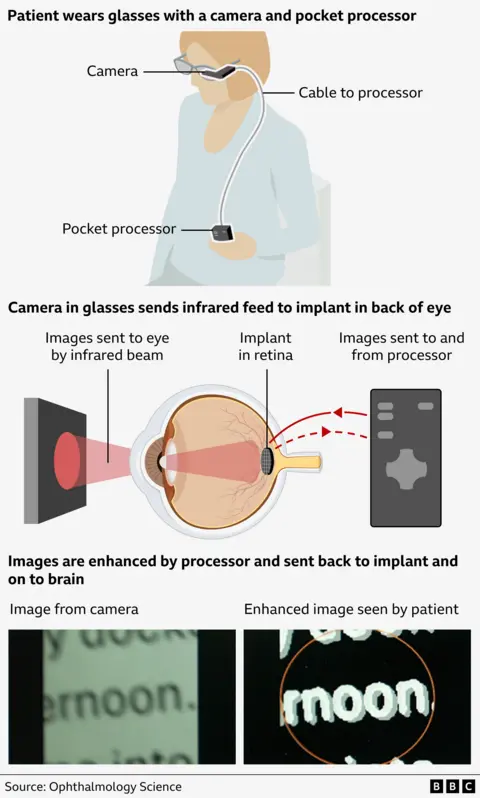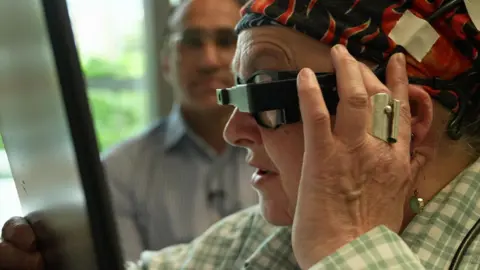Fergus WalshMedical editor
A group of blind patients can now read again after being fitted with a life-changing implant at the back of the eye.
A surgeon who inserted the microchips in five patients at Moorfields Eye Hospital in London says the results of the international trial are “astounding”.
Sheila Irvine, 70, who is registered blind, told the BBC it was “out of this world” to be able to read and do crosswords again. “It’s beautiful, wonderful. It gives me such pleasure.”
The technology offers hope to people with an advanced form of dry age-related macular degeneration (AMD), called geographic atrophy (GA), which affects more than 250,000 people in the UK and five million worldwide.
In those with the condition, cells in a tiny area of the retina at the back of the eye gradually become damaged and die, resulting in blurred or distorted central vision. Colour and fine detail are often lost.
The new procedure involves inserting a tiny 2mm-square photovoltaic microchip, with the thickness of a human hair, under the retina.
Patients then put on glasses with a built-in video camera. The camera sends an infrared beam of video images to the implant at the back of the eye, which sends them on to a small pocket processor to be enhanced and made clearer.
The images are then sent back to the patient’s brain, via the implant and optic nerve, giving them some vision again.
The patients spent months learning how to interpret the images.
Mahi Muqit, consultant ophthalmic surgeon at Moorfields Eye Hospital in London, who led the UK arm of the trial, told the BBC it was “pioneering and life-changing technology”.
“This is the first implant that’s been demonstrated to give patients meaningful vision that they can use in their daily life, such as reading, writing.
“I think this is a major advance,” he said.
How the implant technology works

For the research, published in the New England Journal of Medicine, 38 patients with geographic atrophy in five European countries took part in the trial of the Prima implant, which is made by California biotech Science Corporation.
Of 32 patients given the implant, 27 were able to read again using their central vision. After a year, this equated to an improvement of 25 letters, or five lines, on an eye chart.
For Sheila, from Wiltshire, the improvement is even more dramatic. Without the implant, she is completely unable to read.
But when we filmed Sheila reading an eye chart at Moorfields Hospital, she did not make a single error. After completing it, she punched the air and cheered.
‘I am one happy bunny’

The task took huge concentration. Sheila had to put a pillow under her chin in order to steady the feed from the camera, which can focus on just one or two letters at a time. At some points she needed the device switched to magnification mode, especially to distinguish between the letters C and O.
Sheila began losing her central vision more than 30 years ago, due to loss of cells in the retina. She describes her vision as like having two black discs in each eye.
Sheila gets around using a white cane because her very limited peripheral vision is completely blurred. She is unable to read even the largest street signs when outdoors.
When she had to give up her driving licence, she says she cried.
But after having an implant fitted around three years ago, she is delighted by her progress, as is the medical team at Moorfields.
“I am able to read my post, books, and do crosswords and Sudoku,” she says.
When asked if she ever thought she’d read again, Sheila replied: “Not on your nelly!”
“It is amazing. I am one happy bunny,” she adds.
“Technology is moving so fast, it’s amazing that I am part of it.”

Sheila doesn’t wear the device when outdoors. In part, this is because it requires great concentration – her head has to be held very still in order to read. She also does not want to become over-reliant on the device.
Instead, she says she “rushes her chores” at home each day before sitting down and putting on the special glasses.
The Prima implant is not yet licensed so is not available outside of clinical trials, and it’s unclear how much it may eventually cost.
Nonetheless, Mahi Muqit said he hoped it would be available to some NHS patients “within a few years.”
Dry age-related macular degeneration (AMD) is the most common cause of sight loss in older age. It’s hoped the technology could be used to help people with other eye conditions in the future.
However the implant would not help restore sight in people born blind, because they don’t have a functioning optic nerve to pass signals to the brain.
Disclaimer : This story is auto aggregated by a computer programme and has not been created or edited by DOWNTHENEWS. Publisher: BBC










